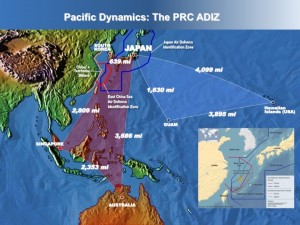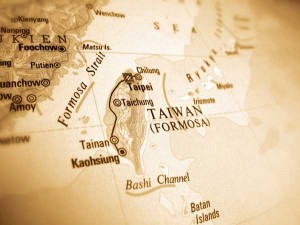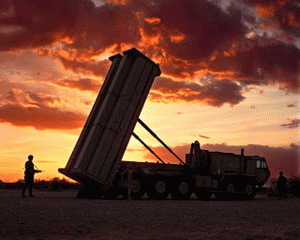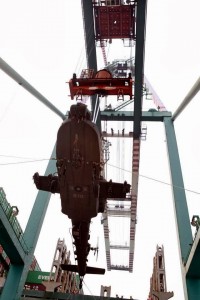2014-02-16 By Ed Timperlake
In trying to make sense of the situation in the Pacific and to shape a 21st century strategy, American civilian leadership must look at the military technology modernization rate of the PLA and then try and understand what PRC “neighbors” are doing.
In poker terms can this could be considered a key “tell.”
The significant distance between Pacific islands, their disbursed locations and physical topography should be understood in a geographic strategic context.

Location capabilities and intentions of both Allies and the PRC should drive essential elements of war plans essential to any credible Pacific defense strategy.
Consequently, with weapon modernization improvements in lethality by a US Pacific Air/Sea Battle strategy defending the island of Taiwan is an essential part of any strategy.
In order to understand the absolute strategic and tactical necessity of making sure the PRC does not take over Twain and turn it into a 21st Century island fortress and launch point, the geography of the Pacific Strategic Quadrangle must be realistically examined.
Around the Pacific, PRC aggressive posturing and emerging quality and quantity of the PLAAF, PLAN and 2nd Artillery makes the potential for combat up-close and very personal. Each nation sees this and is engaged and responding in its own way.
Looking at the challenges along the Pacific Rim, around into the Indian Ocean each nation has different but also similar defense needs.
Russia
North of Korea into the Arctic, Russian forces come into play.
However, it currently looks like Russia is going back to the future in planning on actually using tactical nuclear weapons integrated immediately into any outbreak of hostilities affecting the Russian Far East.
Pondering over the use of both tactical and strategic nuclear weapons by both Russia and China is a huge separate subject beyond this article.
Korea
War plans and the use of appropriate technology to deter or kill the evolving threat of North Korea is a clear and present danger.
Currently there is some very good news with regard to shaping more effective defense for South Korea.
South Korean Civilian leaders and military are looking to bring more focus on technology and upgrade their forces. Their recently announced F-35 purchase and increasing space assets to immediately stop the Dear Leaders over-the-top ranting about unleashing his atomic bombs are key cases in point.
http://www.sldforum.com/2014/02/rethinking-south-korean-defense-second-nuclear-age/
http://www.sldforum.com/2014/02/deterrence-human-factor-second-nuclear-age/
Thus the key question for Korean deterrence can be put directly:
Are war plans focused enough on this problem along with the will to execute?
This is a very good start:
Japan
Japan, is a strong US Ally, they are not only modernizing their TacAir, again F-35 but looking to plus up their Navy along with overhead collection.
It is fair to say they are fully engaged in response to credible threats from the PRC.
The Philippines
The Philippines are poor and to be far they face the worst type of insurgency.
They have two nasty groups engaged concurrently, Communist, the legacy of Huks and also Islamic fighters in southern islands.
The Philippines have an important strategic position, especially in relation to South China Sea, but realistically with any possible PLA threat the worst is they remain neutral.
Realistically, the PLA does not have the assets to invade and conquer the Philippines even if they tried.
And trends are against the PLA.
The USN the Navy/ Marines team, and USAF are beginning to operate from ports and airfields.
American re-engagement is a work in progress and the recent Typhoon humanitarian effort by USAF/USN/USMC assistance was a pitch perfect operation to win friends.
The CNO of the USN Navy/Marine team has put a significant marker down in defending the Philippines.
Vietnam
Looking at the South China Sea, Vietnam Combat leaders have figured out that a current major PLAN weakness is ASW, hence their Russian Sub purchase.
Any combat action of Vietnam versus the PRC at sea around Hainan Island might be very interesting because soon the PLAN will not be shooting up unarmed Vietnamese fishing boats.
Singapore
In going around into the Indian Ocean, Singapore has been very successful in standing alone and Singapore is most definitely wedded to capitalism. They also are engaged with F-35s and buying new German Submarines thus compounding the PLAN ASW challenge.
http://news.usni.org/2013/12/04/singapore-buys-new-class-german-attack-submarines
Indonesia and Malaysia
If the PLA wants to attack and occupy the largest (in numbers) Islamic country on earth, Indonesia and also Malaysia with 65% of their population adherents of Islam, well good luck with that.
Australia
Looking further south to Australia, the Aussies are perfectly positioned for defense in depth.
In addition, to an impressive can-do credible modernizing military, Australia is nation that has never wavered from being an engaged combat ally with America.
Australia also brings additional capability such as reach back logistics, training range, and battle damage repair facilities.
India
Looking at India, the Indians are moving out with enhanced fighting forces into the Indian Ocean and also going around to Vietnam.
India is making some very well thought out and smart moves with modernizing their military technology.
The PRC is generating responses from the Indians which should give the PRC pause.
Taiwan, the Republic of China
The great challenge is Taiwan which is often left out of any strategic equation which supports Pacific defense.
Looking at the geography of the Strategic Quadrangle in the Pacific, it is clear that Taiwan plays a key role.
The Republic of China owns a key dominant piece of Pacific Island real estate and it is imperative that now more than ever the US and the allies must not lose that Island cluster as part of a Pacific defense effort.
And the emphasis clearly is upon DEFENSE effort.
In the 20th Century Taiwan had two key features of significance.
First, it was a template for a Chinese free open dynamic society, which must scare the PRC totalitarian leaders to their core, and this intangible is just as important today as it was years ago.

It is not about the PRC as currently constituted swallowing up Taiwan; it is about the democratic traditions which have developed on Taiwan transforming the Communist state and leading to its collapse.
This is not just about geopolitics but about the future of what kind of China plays what kind of role in the world.
Simply having seminars in Washington with the current class of Chinese Communist leaders will not lead to a better China or a better world.
Second, if one looks only at 20th Century “stove piped” military thinking made up of discreet independent elements, an independent Air Battle, Sea Battle, and Big Army land war, then Taiwan was important.
But true then, and even more significantly now, Taiwan lies at the juncture of effective Pacific DEFENSE.
With US and Allies evolving toward a “no platform fights alone” AIR/SEA cross-domain joint Pacific defense, then it is essential that Taiwan stay aligned with the democracies.
Thankfully, if PLA wants to fight “feet wet,” the US and Allies can still make them fight alone in the dark and die.
How long we keep this edge is a guess, but US forces do train rigorously and have realistic testing in the field and at sea. US and Allied technology with our better-trained and more combat experienced human elements appears be our significant advantage.
For example, of all the combat forces in the world today, the USAF is still a quantum step ahead on their ability to “turn out the lights.” It is a demonstrated war tipping capability and not just assertional capabilities.
However, if the PRC makes a military move a well designed and executed Air/Sea/Land Battle US battle plan leveraging presence, scalability and multiple access can make such an attack become the PLA’s equivalent of the US WWII Battle of the Bulge.
The “Fighting Navy” is fully capable of executing a combat engagement strategy –“if it floats it sinks.”
https://sldinfo.com/how-to-defend-taiwan-in-the-decade-ahead/
Now, with the ever increasing lethality of anti-ship missiles, especially potential hyper-sonic cruise missiles, if the PLA establishes themselves on Taiwan, and has time to dig in, and modernize to their version of “no platform fights alone” it will position the expanded PRC position in the Pacific.
A PRC dominated Taiwan would be militarily poised to disrupt US and allied operations and significantly disrupt the ability to operate in the strategic quadrangle.
If the PLA (generic for all PRC military forces) is given time to dig in and build a robust redundant ISR network from survivable hardened ground facilities and dug in and hardened 2nd Arty missiles batteries, it would be a significant new combat challenge.
The PLA combing survivable ISR 100 plus miles off the China coast linked with sea based platforms, PLAAF attack planes, and their satellites (if they are allowed to survive) can be very deadly at sea for USN.
With the PLA propensity for digging, they will literally dig in, and shape combat capabilities at the heart of the strategic quadrangle.
Taiwan’s geographic position negates the entire concept of the Strategic Quadrangle, ultimately this could be a combat show stopper.
It is no wonder that the self-declared ADIZ was yet another round of the PRC trying to assert its reach and affecting Taiwan.
Losing Taiwan, especially as PLA weapons modernize would be a challenge to any Pacific Air/Sea campaign battle plan.
One mitigating factor is culturally all indicators are that the PLA is still a “hub-spoke” top down military,” which is so 20th Century. Such con-ops can be deadly and get better but still beatable with US Allied Air/Sea evolving technology and con-ops.
The challenge is simply the PLA military concept of “mass” (a lot of combat capability) and survivability if protected correctly.
The US Army could play a key role in providing the kind of allied capabilities which would bolster Taiwan’s ability to DEFEND itself.
How can the US Army play a core role in Taiwan defense?
The first is their making a huge contribution by proliferating their world class Air Defense Capability.
Any country that requests US Big Army support with Air Defense Artillery should be encouraged and engaged.

Rather than tax the USAF to fly other US Army units around the Pacific, by being positioned on Taiwan and sorting out the capability to provide for missile defense FROM Taiwan, the US Army working with Taiwan could shape innovative new approaches to DEFENSE.
With respect to other Army combat skills, their own Field Manual (FM-1) answers the question of their most appropriate role in the Pacific.
The FM “Army and the Profession of Arms” is introduced with a brilliant quote from the late T.R Fehrenbach:
Chapter 1:
The Army and the Profession of Arms
…[Y]ou may fly over a land forever; you may bomb it, atomize it, pulverize it and wipe it clean of life—but if you desire to defend it, protect it, and keep it for civilization, you must do this on the ground, the way the Roman legions did, by putting your young men into the mud.
T.R. Fehrenbach This Kind of War
Putting this into context, recently the Air Force Association published a very smart insightful look at modern Airpower, on the dynamic shift between airpower and land power:
Airpower has eclipsed land power as the primary means of destroying enemy forces.
http://www.airforcemag.com/MagazineArchive/Pages/2014/February 2014/0214reversal.aspx
Earlier, the Brits also paid US Airpower a huge complement in an official MOD report:
“In 2014 our adversaries – state and non-state – will know that to confront the US and its allies in a conventional, force-on-force fight will be to lose; as Professor Colin Gray has said, ‘If an enemy chooses, or has no practical alternative other than to wage warfare in a regular conventional way, US air power will defeat it long before US ground power comes into contact.’”
https://sldinfo.com/evolving-allied-perspectives-2/
Both sources are exactly right except on one type of combat–fighting over island real estate in the Pacific.
Iwo Jima proved the limits of direct fire, Naval Battleship canons shooting point blank shells the weight of a VWs pulverized the Island to little effect. Perhaps different results today could be achieved by accurate air ordinance, and we do have much better “bunker busters.” To be fair US and Allied air against dug in Island defenses, especially over an island the size of Taiwan, is an unresolved ongoing work in progress.

The key of course would be to position oneself not have to fight that battle in the first place: in effect get there first.
One way to signal ROC strategic importance is post more US “Big Army” troops on rotation into Taiwan, rather than have their emerging “Pacific Pathways” plan spend resources trying to achieve relevance around the PacRim as currently reported and demonstrated in Korea.
Proliferating ADA throughout the Pacific Rim and rotating appropriate ground combat units on and off Taiwan is tactically and strategically relevant.
There is no reach here with regard to the strategic relevance of the US Army.
It is imperative, as expressed in the Army’s own FM-1 thinking, to engage with the one country in which they can actually make a difference other than ADA. Rotating units of Big Army on and off Taiwan is their ultimate test case for Pacific Pathways relevance.
A US Army Division (or less to start) rotating in and out of the ROC would be a huge signal to PLA and make a difference in the event of war.
More” Big Army” is not needed in Japan, Korea, Philippines, Singapore et al.–ADA Army is.
Advocating for Big Army to focus on defending Taiwan should be the core element of their Pacific Pathway.
Rotating significant Big Army Units on and off Taiwan legally falls under two major provisions of The Taiwan Relations Act.
The US Army is not an offensive fighting force in the Pacific, unless they advocate fighting a land war in China, which will not and should not ever happen. It is clearly a DEFENSIVE force.
Stationed on Taiwan the Army does not have the ability to maneuver to engage in combat off the Island. Rotating US Army units is purely a defensive signal and falls inside provisions of the Taiwan Relations Act (TRA).
The TRA clearly permits such actions:
“In furtherance of the policy set forth in section 3301 of this title, the United States will make available to Taiwan such defense articles and defense services in such quantity as may be necessary to enable Taiwan to maintain a sufficient self-defense capability.”
Defense Articles are weapon systems which US provides and also are allowed are “services.”
Taking into account the recent courageous fighting skills honed by the US Army from over a decade of combat it would be important to share their insights and provide large unit combined arms training “services” for the ROC Army.
One simple example is the ROC just purchased Apache Helicopters and Army combat experienced pilots could provide realistic training services.
From an American strategic viewpoint, and a signal to all our Pacific Allies, rotating Army units meet the minimum standards of prudent strategic planning as expressed in this provision:
“To maintain the capacity of the United States to resist any resort to force or other forms of coercion that would jeopardize the security, or the social or economic system, of the people on Taiwan.”
History has shown that the PRC loves to tunnel so why not reverse that skill and have the US Army “dig” in on Taiwan.
Like the Army in Germany during the Cold War such a move is a signal of US and Allied resolve. Unlike the cold war victorious US Army in Germany it would be seen as a 100% defensive move.
If not the US Army who will provide allied defense of Taiwan?
If not now when?
Editor’s Note: For a comprehensive look at a 21st century Pacific Defense strategy see the following:
https://sldinfo.com/rebuilding-american-military-power-in-the-pacific-a-21st-century-strategy/
Credit for Apache photo:
http://chinesemilitaryreview.blogspot.com/2013/11/taiwanese-ah-64e-apache-block-iii.html

